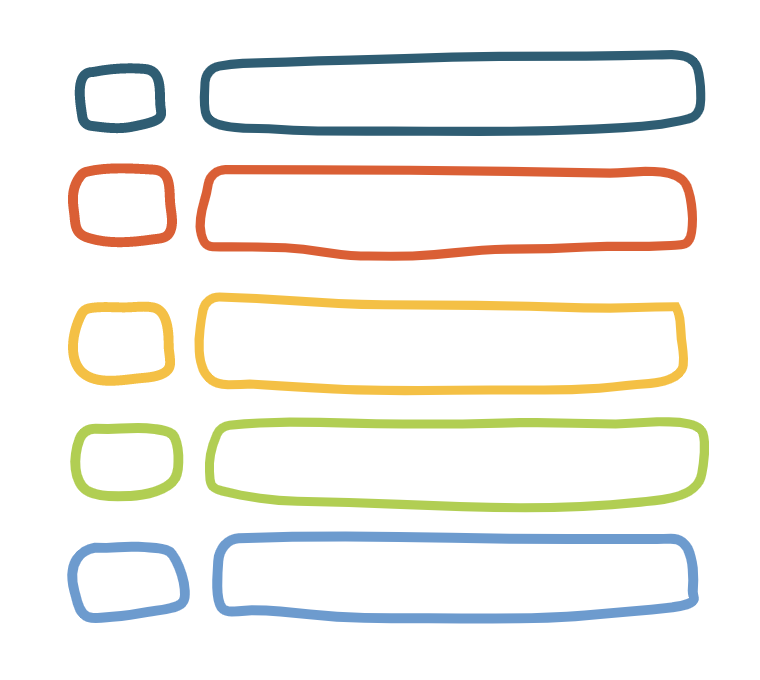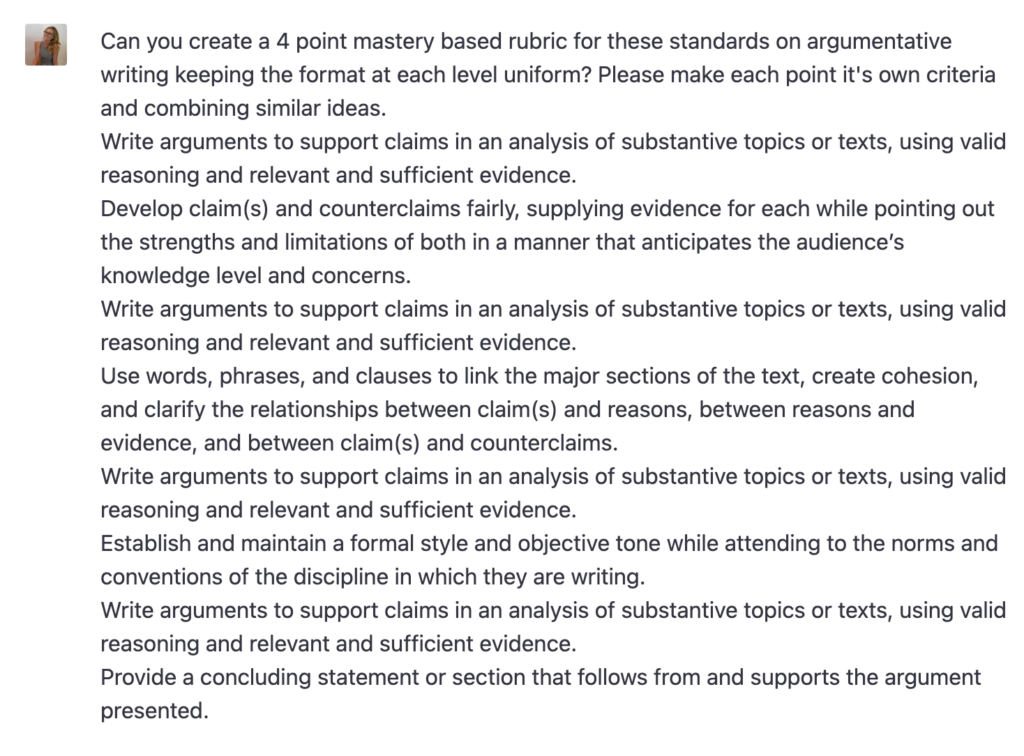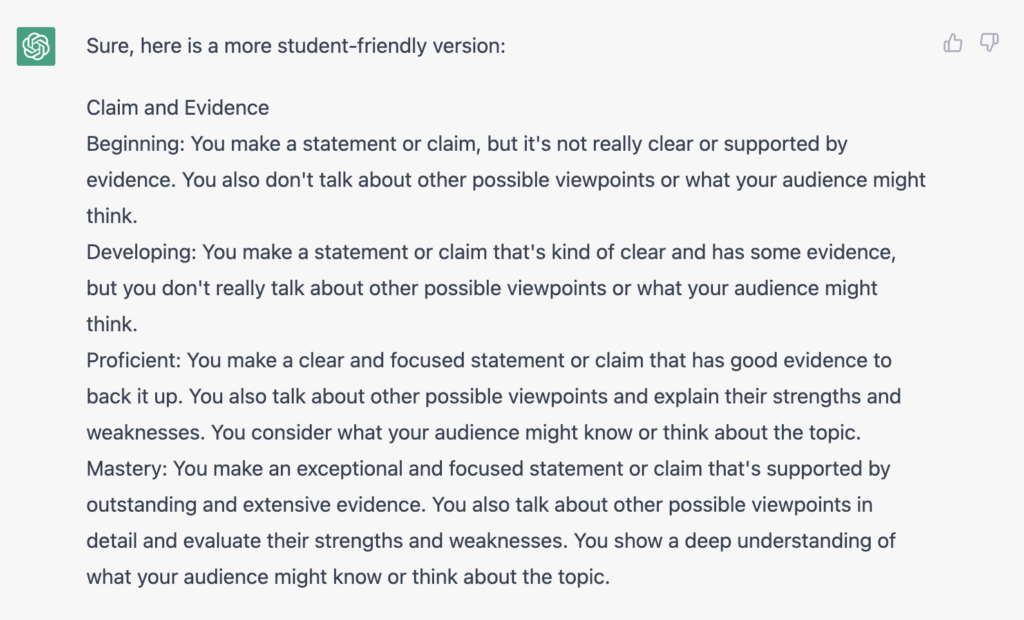In a previous blog post and corresponding podcast, I said, “if teachers design student-centered learning experiences that allow students to write with support in class, ChatGPT won’t be nearly as disruptive as some articles claim.” In the two months since I published that post, I’ve had the opportunity to play with ChatGPT, exploring how teachers across subject areas can leverage AI technology to enhance the writing process and ease the burden on teachers (always my goal!). Below are some ideas for leveraging this AI technology to lessen a teacher’s workload and engage students more completely in the writing process.
Generate Personalized Writing Prompts
When students are given writing assignments, they rarely have much agency or choice about what they write about, negatively impacting their motivation to write. One reason teachers may not give students more meaningful decisions in relation to writing is the time it takes for us to generate high-quality writing prompts. AI technology can be beneficial on that front.
Instead of generating the writing prompts and giving them to students, why not engage students in the process of generating their own prompts in relation to a specific topic, subject, or issue? The process might look something like this:
- The teacher introduces the topic, subject, issue, or style of writing and provides examples of writing prompts to the class. Note: Teachers can use AI to generate these example prompts to save time.
- Students discuss the topic and brainstorm prompt ideas that fit within the given category or style.
- Students submit their writing prompt ideas to an AI technology tool, like ChatGPT, for feedback and refinement.
- After students receive feedback, they can share their ideas with their peers or in small groups. That way, if one student has a prompt that other classmates are interested in using, they can select their favorite student-generated prompt and benefit from their peers’ ideas.
- The teacher reviews the prompts, ensuring they are high quality, appropriate, and meet the assignment’s learning objectives.
Analyze and Critique Strong Examples
Asking students to analyze and critique strong examples of writing can help them understand the elements of effective writing, such as structure, voice, and style, and provide them with a model of what they are working toward in their writing.
Unless a teacher has kept samples of exemplary work created by previous students, generating strong examples for students to work with can be time-consuming. Teachers can leverage AI technology to produce strong writing samples for students to analyze and critique, saving them significant time. Once teachers have generated two or three strong examples, they can structure the analysis process with an activity, like the analyzing writing exemplars pictured below.
To make this process engaging and collaborative in the classroom, teachers can strategically pair or group students for this exercise. This activity can be pulled into a station rotation lesson or built into a writing playlist.
By working together, students can share their perspectives and insights and learn from each other. Finally, teachers can ask students to apply what they have learned to their own writing, encouraging them to use the strong example as a model for their work.
A Partner in the Pre-writing Process
For many students, the most challenging part of the writing process is getting started. AI technology can be a helpful brainstorming partner, resource curator, and idea organizer!
A tool like ChatGPT can combat the paralysis that often accompanies a blank page or screen and help students generate ideas for their writing assignments by providing topic suggestions and a list of related keywords to help students develop and organize their thoughts on a topic. AI tools can also assist students in organizing their ideas into an outline by identifying key points, suggesting subtopics, and providing direction on the best way to present those ideas.
AI-powered search engines can help guide students during their research process. These tools can recommend relevant and credible sources, helping students navigate the vast amount of information on the internet.
By leveraging AI technology during the prewriting process, students can benefit from efficient and effective support, allowing them to produce higher-quality writing in a shorter amount of time. Ultimately, this can lead to improved writing skills and increased confidence in their writing abilities.
Unlimited Feedback
Feedback is how students feel seen and supported in a classroom, but teachers are juggling a lot and may not have time to look at each student’s work to provide meaningful feedback. AI technology, on the other hand, can give instant feedback anytime, anywhere. Students can receive feedback on their writing as soon as they finish without waiting for their teacher. It will likely be more motivating as it eliminates the “wait time” between completing a task and getting feedback. Essentially, students can stay in the flow and engage in more self-directed work in the classroom (and beyond).
AI feedback is specific and targeted, helping students to identify areas for improvement in their writing, such as grammar, syntax, and organization. This type of feedback can help students develop their writing skills more effectively and efficiently, as they can receive guidance on areas of weakness in real-time and make improvements as they go.
AI feedback may also be more objective and unbiased than feedback from a teacher because it is based on data and algorithms rather than personal opinions. This can help ensure that all students receive consistent and equitable feedback, regardless of their background or performance. It also presents an opportunity for students to think critically about the feedback they receive since algorithms may suggest edits or revisions that do not work to improve a piece.
Create Mastery-based Rubrics
Rubrics create a roadmap for success that students can use to guide their work on writing assignments. The best rubrics limit the number of criteria to avoid overwhelming learners. They also clearly describe what learning looks like at different levels of mastery: beginning, developing, proficient, and mastery.
Like most teacher tasks, designing a rubric can take significant time. This is where AI technology, like ChatGPT, can also be incredibly helpful. Teachers can take the language from their standards to create standards-aligned, mastery-based rubrics in a fraction of the time it would have taken before AI.
Here is how it works. First, copy and paste your state standards for a writing assignment into ChatGPT.
ChatGPT responded by identifying four main criteria for this writing assignment based on the language of the standards. It wasn’t exactly what I asked it to do, but it helped sort through the clutter of all these aspects of argumentative writing to identify four criteria I might want to assess. This is where the teacher, as subject area expert, needs to decide whether the criteria identified are the ones they want to assess.
I asked ChatGPT to break down each criterion it had identified into four levels of mastery and explicitly told it I wanted a beginning, developing, proficient, and mastery level. It generated this for the first criteria, “Claim and Evidence.”
Again, the answer here isn’t an example of something a teacher can copy, paste, and reuse without edits. There are words, like substantiated, that students may not understand. Since the goal of the rubric is to create a student-friendly roadmap for success, teachers will need to read through the language closely, revising it to work for their audience. In fact, you can ask ChatGPT to reword a section in “more student-friendly language” to ensure your learners can understand what is expected of them.
Let’s face it–writing is hard, and creating assignments, exemplars, and rubrics can be just as challenging. AI technology can be a game-changer for teachers and students alike. Teachers who leverage AI technology can provide their students with more personalized support and make the writing process less daunting for everyone involved. Rather than fearing the rise of AI, I’d love to see educators embrace it and see it as an opportunity to enhance the learning experience and reimagine when, where, and how writing takes place. As technology continues to develop and improve, we can make teaching more sustainable and learning more engaging than ever before.
A friend of mine shared a quote he had heard that said, “AI won’t take your job. The person who knows how to leverage AI will take your job.” That resonated with me. This is particularly true in education, where the slow pace of change often prevents us from adopting new technologies. While much of the current conversation surrounding AI in education is negative and focuses on cheating, the truth is that AI can transform the way we teach and learn. By bringing the writing process into the classroom and using AI to support students throughout the process, we can create an environment where students can become confident writers. With the help of AI, we can provide personalized support to each student and make the writing process less daunting. I’d love to see teachers leverage this technology to improve our practice and enhance the learning experience for our students.
Professional Learning Opportunity
I’m offering virtual and in-person workshops focused on teaching with AI technology. If your teachers need support, contact me about the workshop described below.
Teaching in Harmony with Advancing AI Technology
Writing is a fundamental skill that supports learning across all subjects, but it can be challenging for students to complete in isolation at home. This workshop aims to demonstrate the importance of pulling the writing process into the classroom, where students can write with support and feedback from their peers and teachers.
During this workshop, participants will learn how to effectively use AI tools to enhance writing instruction, provide feedback, and support students in generating and organizing ideas. The workshop will also explore how AI can help teachers assess student writing and provide personalized feedback, saving time and increasing student engagement. By bringing the writing process into the classroom, students can benefit from the support and guidance of their peers and teachers, which helps them to improve their writing skills more quickly and effectively.











6 Responses
This is very practical and reflects experience. Great. A the Sentient Syllabus Project I focus on higher ed, but the principles are very similar. The resources linked from http://sentientsyllabus.org may be useful to you, as well as the analyses I publish on Substack – for example I discuss some limits on AI involvement, and why it is probably better not to _start_ from AI generated text here: https://sentientsyllabus.substack.com/p/how-much-is-too-much . Recently I developed some ideas around crafting personalized prompts, and that could be an interesting addition to the personalized assignment toolkit – too much to fit into this margin, but you are welcome to get in touch. Thanks for the good ideas!
Thank you for sharing your work, Boris! This looks fascinating. I appreciate you sharing it.
Take care.
Catlin
Dear Catlin, your videos dedicated to Blended learning helped me lot in Teaching, in sharing this approach, now thank you for Great vision reagarding developing writing skills!!!
You’re so welcome, Svetlana. I am thrilled my videos have been useful.
Take care.
Catlin
Hello Dr. Tucker,
I agree; I struggle to design rubrics that are easy for students to understand. I appreciate your recommendations; I will be sure to check out ChatGPT as I am looking for an online rubric generator that students can interact with.
You’re welcome, Kellee!